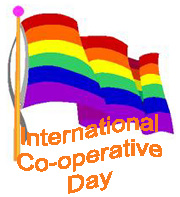 In 1921, at the International Co-operative Congress of World
Co-op Leaders wanted to identify and define the growing co-operative
movement's common values and ideals to help unite co-ops around the world.
They decided to hold a special event to celebrate the movement's growing
diversity. In 1921, at the International Co-operative Congress of World
Co-op Leaders wanted to identify and define the growing co-operative
movement's common values and ideals to help unite co-ops around the world.
They decided to hold a special event to celebrate the movement's growing
diversity.
In Essen, Germany in 1922, ICA
(國際合作聯(lián)盟)leaders made plans for the very first international
"Co-operators' Day" which was held in July 1923. Since then, on the first
Saturday every July, International Co-operative Day has been celebrated.
The day is a chance for co-op members and supporters to work together and
promote the co-op movement's successes and ideals of international solidarity(團(tuán)結(jié)), economic efficiency, equality, and
world peace. To celebrate the Centennial(百年紀(jì)念)of the International Co-operative Alliance,
the United Nations declared in 1995 that the first Saturday of July to be
celebrated as the United Nations International Day of Co-operatives and
requested all member governments to join with their co-operative movements
to celebrate the day.
Over several years various national movements were trying to register
the Rainbow Flag as a trade mark, seeking ICA help in finding out
arguments to prove that the flag is a distinctive(與眾不同的���、有特色的)symbol, reserved to the
co-op movement. For us, co-operators it is, but in fact, it has never been
registered as the ICA symbol.
After the Basel Congress in 1921, which was the first congress to be
held after an interruption of eight years caused by the Great World War
and facing the new challenges in Europe, the ICA Executive Committee
decided to devote some time to Co-operative Propaganda. The membership had
grown dramatically, thus, the idea was to find a point of rally(集合、集會) which
would give an identity to movements scattered(分散) from
Japan to Canada.
 The political map, and most singularly(特別地���,異常地)Europe's political map, changed
to such an extension that it become urgent to find some common denominator(共同特性)for all the different co-operative
traditions. At the same time the established co-operatives suffered
attacks from fascist and communist The political map, and most singularly(特別地���,異常地)Europe's political map, changed
to such an extension that it become urgent to find some common denominator(共同特性)for all the different co-operative
traditions. At the same time the established co-operatives suffered
attacks from fascist and communist
parties both of which claimed
"property rights" on co-op doctrine(主義�、學(xué)說)and
incidentally on co-op assets.
In these troubled times, the ICA President, G.J.D.C. Goedhart,
questioned himself on the causes which hinder the development of the co-op
movement. He detected three: lack of information among the general public,
lack of knowledge among members and finally lack of ideological commitment
among managers.
"What can be done to remedy (治療��、矯正)these
evils? The best means seems to be by general propaganda which must bring
to the minds and hearts of outsiders, as in a flash, vivid pictures of the
Co-operative Movement, the ideals for which it stands, the real
significance of its aims, and how it must necessary give us a much better
human society than that in which we live."
And already in 1922 the best support for publicity appeared to him to
be a film. However, since not many societies could have supported such a
financial investment, he suggested children's books, lantern slides (幻燈片)and other means of visual
propaganda such as exhibitions.
"Arrangements should also be made to hold a "Propaganda Day" or
"Evening" in every country, town and village on the same day in order to
draw the attention of the universe to what we are doing, and also to the
whole world"
A special "Co-operators' Day" is necessary for this purpose. You are,
therefore, called upon to rally to the Standard of "Each for all, all for
each" in a great International Demonstration on the First Saturday in July
next, when the first organized attempt will be made to "broadcast" our
rejoicings(歡慶), our ideals, our successes,
and our determination to pursue them to their ultimate goal.
|